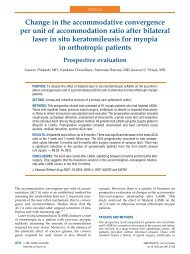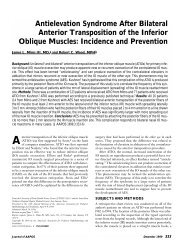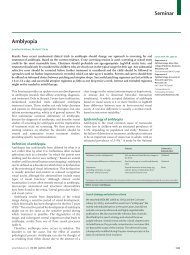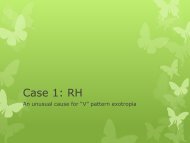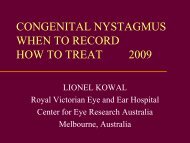What's new AAPOS 2008 - The Private Eye Clinic
What's new AAPOS 2008 - The Private Eye Clinic
What's new AAPOS 2008 - The Private Eye Clinic
Create successful ePaper yourself
Turn your PDF publications into a flip-book with our unique Google optimized e-Paper software.
ocular findings include optic nerve head abnormalities (elevated discs), tortuous or<br />
abnormal branching of vessels, and retinal pigmentary changes (diffuse<br />
hypopigmentation of the fundus, peripapillary hypopigmentation or speckling of the RPE<br />
peripherally). Patients with Alagille syndrome generally retain good vision. ERGs<br />
reports have been variable, though the authors state that ERGs and perimetry should<br />
be considered given the presence of retinopathy.<br />
Genetics of hereditary vitreoretinal degenerations<br />
Pachydaki SI, Young LH.<br />
Semin Ophthalmol 2007 Oct-Dec; 22(4):219-227.<br />
This is a review article targeting specific diseases. Of note is the discussion of the 5q<br />
vitreoretinopathies: Wagner syndrome, Jansen syndrome and erosive vitreoretinopathy.<br />
None have associated systemic features. <strong>The</strong> incidence of tractional RD in Wagner’s is<br />
25%, but age dependent: over 50% of patients>45 develop TRD and over 90% develop<br />
cataracts. Also on 5q14 is Erosive vitreoretinopathy characterized by presenile<br />
cataracts, vitreous veils with traction, no optically empty vitreous. In the<br />
chondrodysplasias associated with vitreoretinopathy there are vitreous and skeletal<br />
abnormalities associated with collagen abnormalities (COL II, IX, XI). Kniest Dysplasia<br />
has more severe systemic manifestations than those in Stickler syndrome: high<br />
myopia, optically empty vitreous, lattice degeneration and RD. Knobloch syndrome<br />
includes high myopia, RD, and midfacial hyploplasia, but also midline scalp defects and<br />
encephalocele. Goldman Favre degeneration and enhanced S-cone syndrome present<br />
with overlapping clinical findings and genetic studies that these two syndromes<br />
represent the same disease entity at a molecular level and have the same geneti c<br />
basis. Neurofibromatosis Type 1: Genetics and clinical manifestations.<br />
Neurofibromatosis type 1: genetics and clinical manifestations<br />
Savar A, Cestari DM.<br />
Semin Ophthalmol <strong>2008</strong>; 23(1):45-51.<br />
This is a general review article of this autosomal dominant multisystem disorder.<br />
<strong>Clinic</strong>al Manifestations by System: Diagnostic Findings in Italics<br />
Ophthalmic<br />
• Lisch nodules<br />
• Glaucoma<br />
• Ptosis<br />
• Retinal astrocytic hamartomas<br />
• Retinal capillary hemangiomas<br />
• Combined hamartomas of the retina and retinal pigment epithelium<br />
Nervous System<br />
• Optic Pathway Gliomas<br />
• Neurofibromas – plexiform, spinal<br />
• Malignant peripheral nerve sheath tumors<br />
• Cerebrovascular disease<br />
• Cognitive deficits<br />
• Epilepsy<br />
Dematologic<br />
64



